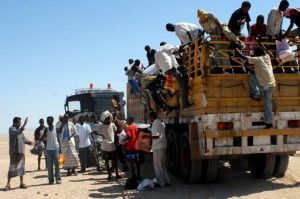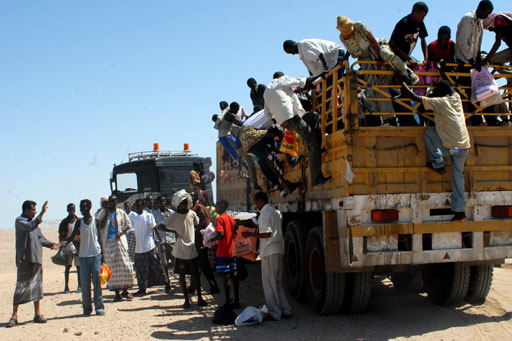
AFP PHOTO / Khaled Fazaa
The number of refugees and migrant workers travelling from the Horn of Africa to Yemen between January and July this year reached an unprecedented total of 63,800, according to the United Nations High Commissioner for Refugees (UNHCR).
The migrants undertake a dangerous voyage across the Gulf of Aden, the Arabian Sea, or the Red Sea in smugglers’ boats to reach the Arabian Peninsula.
“Our primary concern is for those fleeing conflict and persecution and who are forced to resort to any available means to reach safety in neighbouring countries – in this case, meaning taking boats operated by smugglers,” said to UNHR spokesperson Melissa Fleming at a Geneva press briefing.
Fleming also pointed out that an increasing number of Ethiopians have been using smugglers to leave Africa, with more than 51,000 making the trip so far this year. Refugees fleeing from Somalia had previously represented between one quarter and a third of the total, but the increased numbers of Ethiopians has reduced the ratio of Somali refugees in this year’s first seven months to a sixth.
Somalis are automatically recognised as refugees in neighbouring countries and can usually access documentation that confirms their status. However, Ethiopian refugees are not and must sidestep authorities in order to avoid detention and deportation. All refugees in Yemen are at risk of falling victim to human trafficking groups that transport them to other Gulf States. These groups, like the smuggling ships that carry refugees over, are frequently accused of the abuse and rape of, and theft from, refugees.
Fleming also anticipated a large spike in refugees fleeing to Yemen once August data is released, as many of those fleeing perceive that Yemeni and Saudi border patrols operate in a more relaxed manner during Ramadan. According to Fleming, Ramadan in the Gulf States also provides more opportunity for work for migrant workers, and also greater zakat (charity).
The number of refugees crossing water to reach Yemen represents a 30 percent increase from last year when 103,000 used smugglers ships in 2011. This was a previous high since the UNHR started monitoring the movement in 2006.
A variety of factors including domestic unrest and lack of economic opportunity motivate thousands of East Africans to seek asylum in neighbouring countries and find employment, often sending remittances back to family members. Droughts, especially in Ethiopia have further exacerbated movement to Yemen.






